Organisational Behaviour Analysis: David & Co. Limited Report
VerifiedAdded on 2020/10/23
|14
|3967
|449
Report
AI Summary
This report provides an in-depth analysis of organizational behavior within A David & Co. Limited, a food production and distribution company. It explores the influence of organizational culture, politics, and power on employee behavior and performance. The report examines various concepts and philosophies of organizational behavior, including Handy's cultural typology model, and discusses how these factors impact the workforce. Furthermore, it delves into motivational theories such as Maslow's hierarchy of needs and Vroom's expectancy theory, and their application in encouraging employees, especially during office relocation. The report also covers topics like organizational politics, the impact of power dynamics, and the application of different power theories like legitimate, reward, coercive, expert, referent, and informational power. The study highlights the importance of understanding these elements for effective management and achieving organizational goals, offering practical insights into fostering a positive and productive work environment.
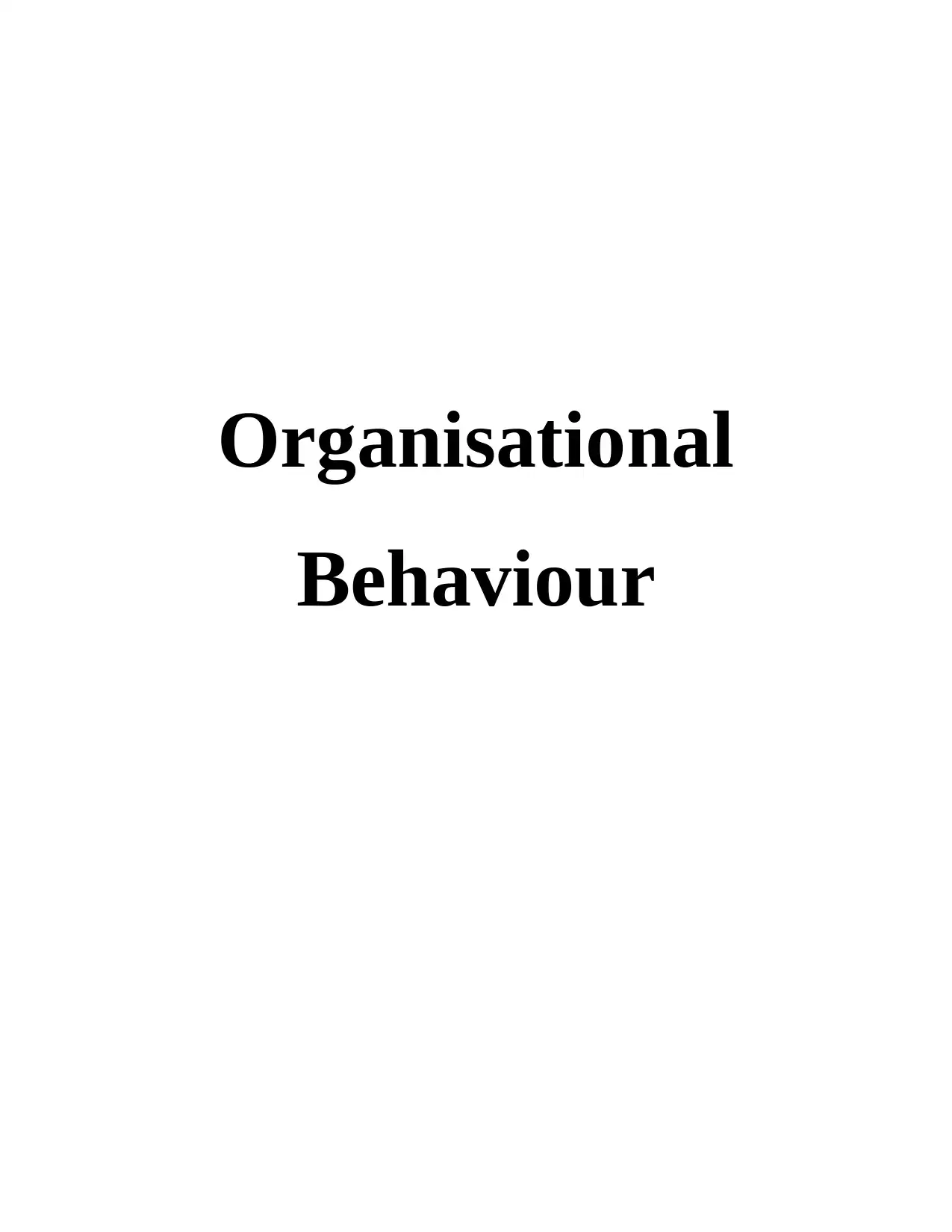
Organisational
Behaviour
Behaviour
Paraphrase This Document
Need a fresh take? Get an instant paraphrase of this document with our AI Paraphraser
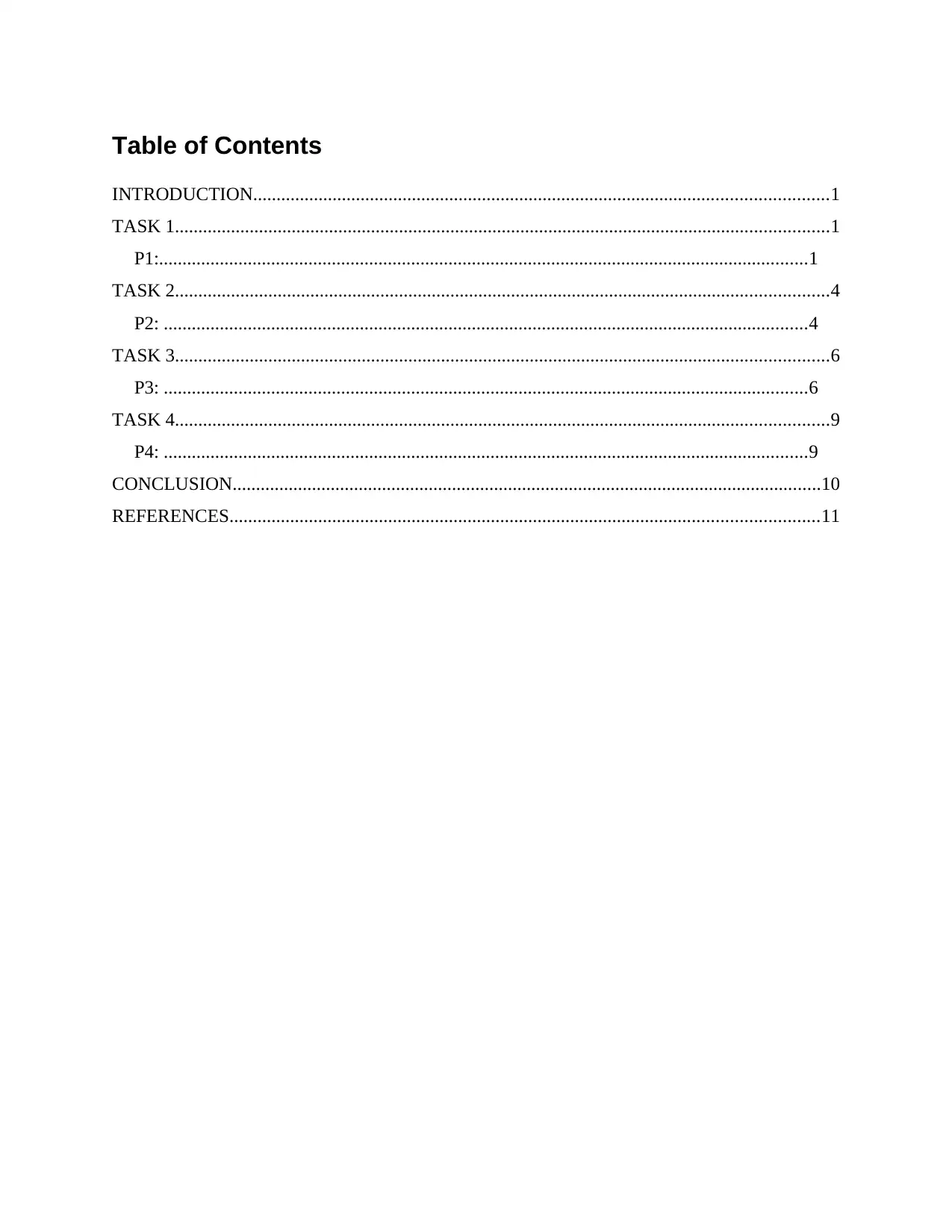
Table of Contents
INTRODUCTION...........................................................................................................................1
TASK 1............................................................................................................................................1
P1:...........................................................................................................................................1
TASK 2............................................................................................................................................4
P2: ..........................................................................................................................................4
TASK 3............................................................................................................................................6
P3: ..........................................................................................................................................6
TASK 4............................................................................................................................................9
P4: ..........................................................................................................................................9
CONCLUSION..............................................................................................................................10
REFERENCES..............................................................................................................................11
INTRODUCTION...........................................................................................................................1
TASK 1............................................................................................................................................1
P1:...........................................................................................................................................1
TASK 2............................................................................................................................................4
P2: ..........................................................................................................................................4
TASK 3............................................................................................................................................6
P3: ..........................................................................................................................................6
TASK 4............................................................................................................................................9
P4: ..........................................................................................................................................9
CONCLUSION..............................................................................................................................10
REFERENCES..............................................................................................................................11
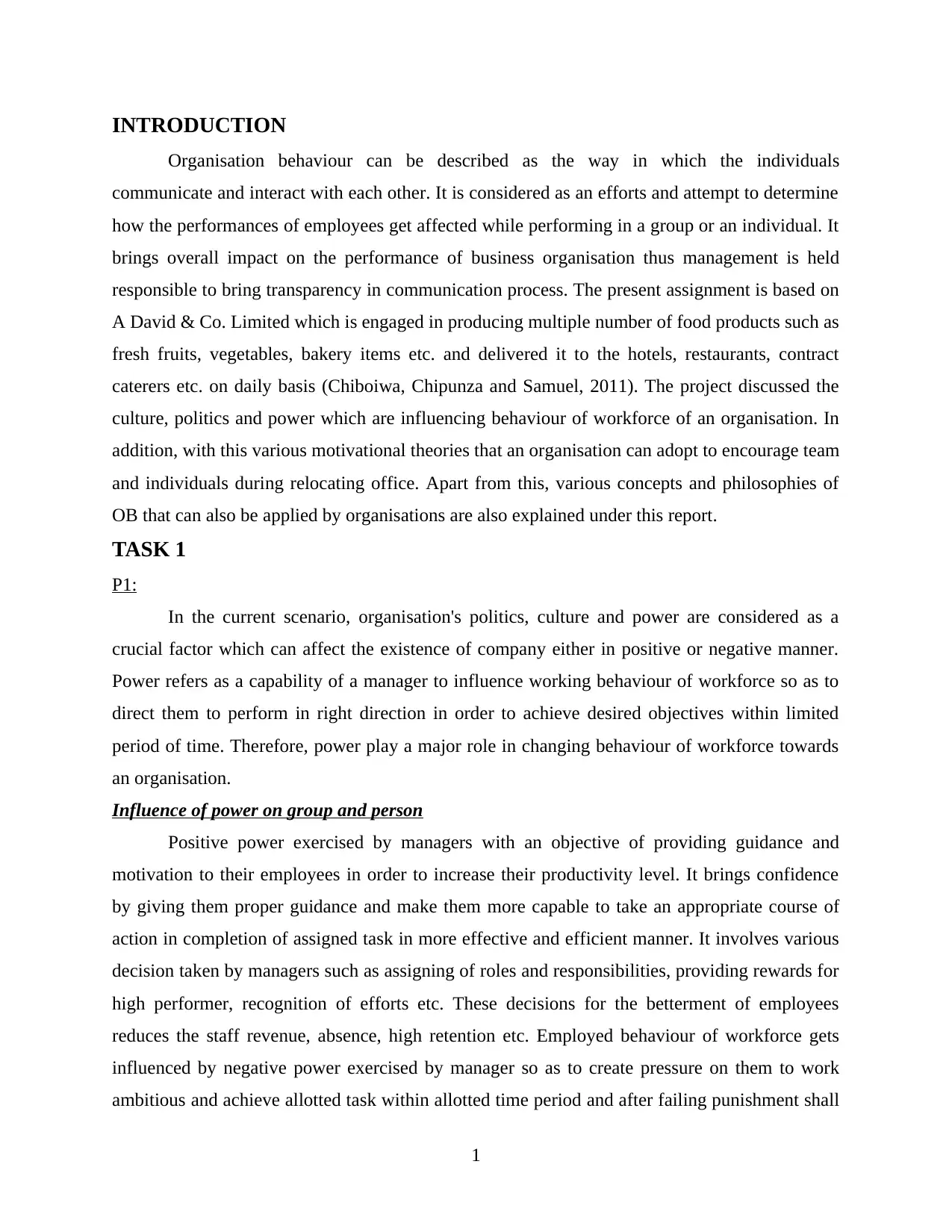
INTRODUCTION
Organisation behaviour can be described as the way in which the individuals
communicate and interact with each other. It is considered as an efforts and attempt to determine
how the performances of employees get affected while performing in a group or an individual. It
brings overall impact on the performance of business organisation thus management is held
responsible to bring transparency in communication process. The present assignment is based on
A David & Co. Limited which is engaged in producing multiple number of food products such as
fresh fruits, vegetables, bakery items etc. and delivered it to the hotels, restaurants, contract
caterers etc. on daily basis (Chiboiwa, Chipunza and Samuel, 2011). The project discussed the
culture, politics and power which are influencing behaviour of workforce of an organisation. In
addition, with this various motivational theories that an organisation can adopt to encourage team
and individuals during relocating office. Apart from this, various concepts and philosophies of
OB that can also be applied by organisations are also explained under this report.
TASK 1
P1:
In the current scenario, organisation's politics, culture and power are considered as a
crucial factor which can affect the existence of company either in positive or negative manner.
Power refers as a capability of a manager to influence working behaviour of workforce so as to
direct them to perform in right direction in order to achieve desired objectives within limited
period of time. Therefore, power play a major role in changing behaviour of workforce towards
an organisation.
Influence of power on group and person
Positive power exercised by managers with an objective of providing guidance and
motivation to their employees in order to increase their productivity level. It brings confidence
by giving them proper guidance and make them more capable to take an appropriate course of
action in completion of assigned task in more effective and efficient manner. It involves various
decision taken by managers such as assigning of roles and responsibilities, providing rewards for
high performer, recognition of efforts etc. These decisions for the betterment of employees
reduces the staff revenue, absence, high retention etc. Employed behaviour of workforce gets
influenced by negative power exercised by manager so as to create pressure on them to work
ambitious and achieve allotted task within allotted time period and after failing punishment shall
1
Organisation behaviour can be described as the way in which the individuals
communicate and interact with each other. It is considered as an efforts and attempt to determine
how the performances of employees get affected while performing in a group or an individual. It
brings overall impact on the performance of business organisation thus management is held
responsible to bring transparency in communication process. The present assignment is based on
A David & Co. Limited which is engaged in producing multiple number of food products such as
fresh fruits, vegetables, bakery items etc. and delivered it to the hotels, restaurants, contract
caterers etc. on daily basis (Chiboiwa, Chipunza and Samuel, 2011). The project discussed the
culture, politics and power which are influencing behaviour of workforce of an organisation. In
addition, with this various motivational theories that an organisation can adopt to encourage team
and individuals during relocating office. Apart from this, various concepts and philosophies of
OB that can also be applied by organisations are also explained under this report.
TASK 1
P1:
In the current scenario, organisation's politics, culture and power are considered as a
crucial factor which can affect the existence of company either in positive or negative manner.
Power refers as a capability of a manager to influence working behaviour of workforce so as to
direct them to perform in right direction in order to achieve desired objectives within limited
period of time. Therefore, power play a major role in changing behaviour of workforce towards
an organisation.
Influence of power on group and person
Positive power exercised by managers with an objective of providing guidance and
motivation to their employees in order to increase their productivity level. It brings confidence
by giving them proper guidance and make them more capable to take an appropriate course of
action in completion of assigned task in more effective and efficient manner. It involves various
decision taken by managers such as assigning of roles and responsibilities, providing rewards for
high performer, recognition of efforts etc. These decisions for the betterment of employees
reduces the staff revenue, absence, high retention etc. Employed behaviour of workforce gets
influenced by negative power exercised by manager so as to create pressure on them to work
ambitious and achieve allotted task within allotted time period and after failing punishment shall
1
⊘ This is a preview!⊘
Do you want full access?
Subscribe today to unlock all pages.

Trusted by 1+ million students worldwide
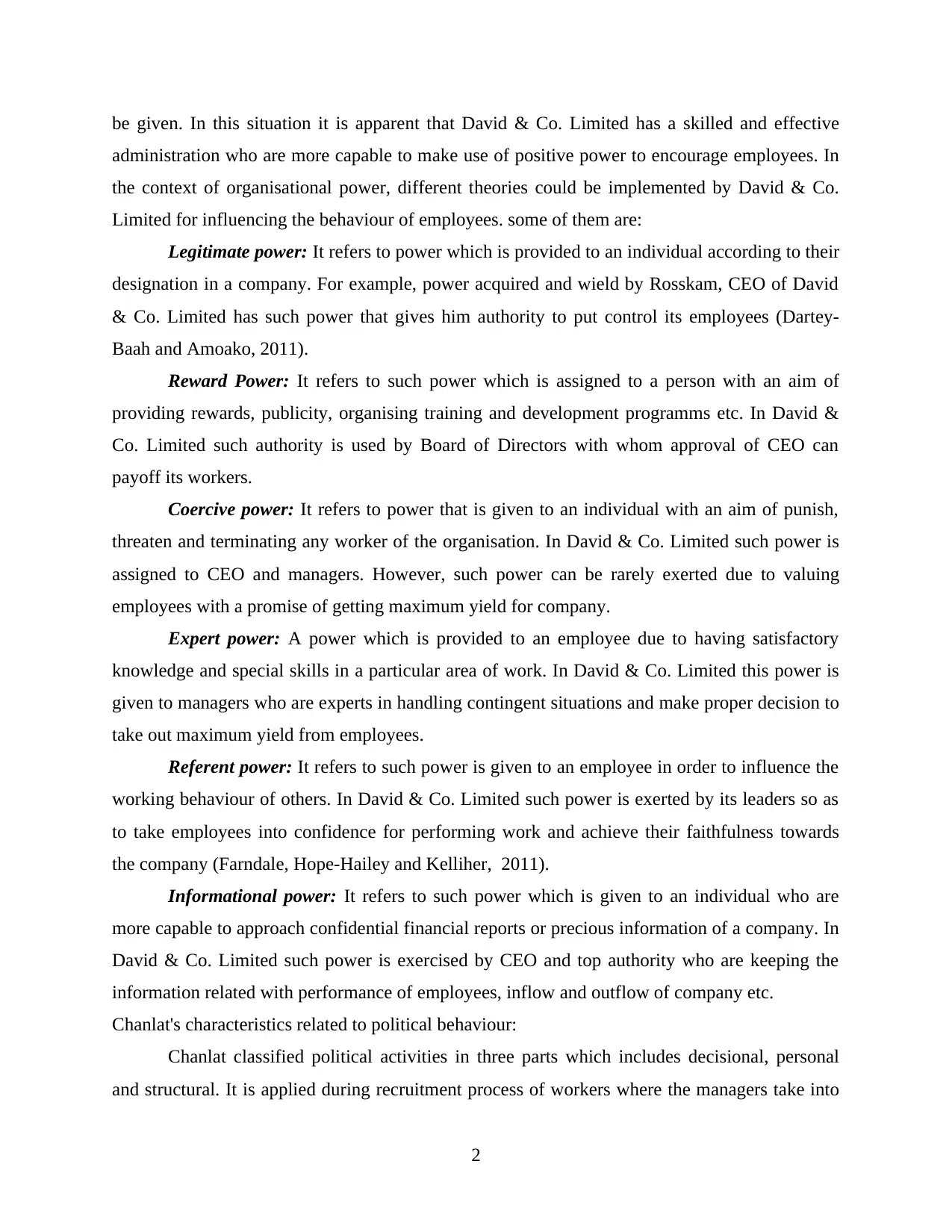
be given. In this situation it is apparent that David & Co. Limited has a skilled and effective
administration who are more capable to make use of positive power to encourage employees. In
the context of organisational power, different theories could be implemented by David & Co.
Limited for influencing the behaviour of employees. some of them are:
Legitimate power: It refers to power which is provided to an individual according to their
designation in a company. For example, power acquired and wield by Rosskam, CEO of David
& Co. Limited has such power that gives him authority to put control its employees (Dartey-
Baah and Amoako, 2011).
Reward Power: It refers to such power which is assigned to a person with an aim of
providing rewards, publicity, organising training and development programms etc. In David &
Co. Limited such authority is used by Board of Directors with whom approval of CEO can
payoff its workers.
Coercive power: It refers to power that is given to an individual with an aim of punish,
threaten and terminating any worker of the organisation. In David & Co. Limited such power is
assigned to CEO and managers. However, such power can be rarely exerted due to valuing
employees with a promise of getting maximum yield for company.
Expert power: A power which is provided to an employee due to having satisfactory
knowledge and special skills in a particular area of work. In David & Co. Limited this power is
given to managers who are experts in handling contingent situations and make proper decision to
take out maximum yield from employees.
Referent power: It refers to such power is given to an employee in order to influence the
working behaviour of others. In David & Co. Limited such power is exerted by its leaders so as
to take employees into confidence for performing work and achieve their faithfulness towards
the company (Farndale, Hope-Hailey and Kelliher, 2011).
Informational power: It refers to such power which is given to an individual who are
more capable to approach confidential financial reports or precious information of a company. In
David & Co. Limited such power is exercised by CEO and top authority who are keeping the
information related with performance of employees, inflow and outflow of company etc.
Chanlat's characteristics related to political behaviour:
Chanlat classified political activities in three parts which includes decisional, personal
and structural. It is applied during recruitment process of workers where the managers take into
2
administration who are more capable to make use of positive power to encourage employees. In
the context of organisational power, different theories could be implemented by David & Co.
Limited for influencing the behaviour of employees. some of them are:
Legitimate power: It refers to power which is provided to an individual according to their
designation in a company. For example, power acquired and wield by Rosskam, CEO of David
& Co. Limited has such power that gives him authority to put control its employees (Dartey-
Baah and Amoako, 2011).
Reward Power: It refers to such power which is assigned to a person with an aim of
providing rewards, publicity, organising training and development programms etc. In David &
Co. Limited such authority is used by Board of Directors with whom approval of CEO can
payoff its workers.
Coercive power: It refers to power that is given to an individual with an aim of punish,
threaten and terminating any worker of the organisation. In David & Co. Limited such power is
assigned to CEO and managers. However, such power can be rarely exerted due to valuing
employees with a promise of getting maximum yield for company.
Expert power: A power which is provided to an employee due to having satisfactory
knowledge and special skills in a particular area of work. In David & Co. Limited this power is
given to managers who are experts in handling contingent situations and make proper decision to
take out maximum yield from employees.
Referent power: It refers to such power is given to an employee in order to influence the
working behaviour of others. In David & Co. Limited such power is exerted by its leaders so as
to take employees into confidence for performing work and achieve their faithfulness towards
the company (Farndale, Hope-Hailey and Kelliher, 2011).
Informational power: It refers to such power which is given to an individual who are
more capable to approach confidential financial reports or precious information of a company. In
David & Co. Limited such power is exercised by CEO and top authority who are keeping the
information related with performance of employees, inflow and outflow of company etc.
Chanlat's characteristics related to political behaviour:
Chanlat classified political activities in three parts which includes decisional, personal
and structural. It is applied during recruitment process of workers where the managers take into
2
Paraphrase This Document
Need a fresh take? Get an instant paraphrase of this document with our AI Paraphraser
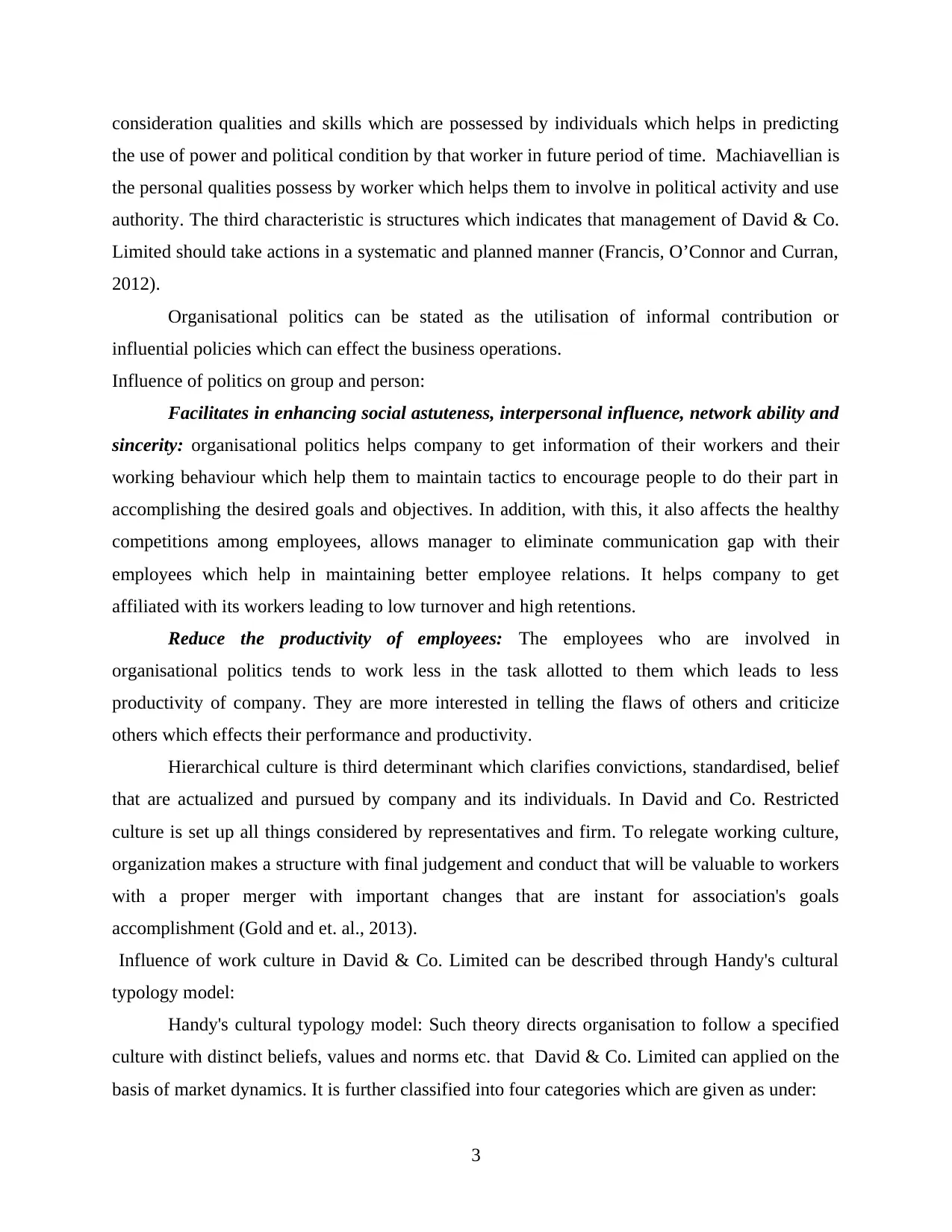
consideration qualities and skills which are possessed by individuals which helps in predicting
the use of power and political condition by that worker in future period of time. Machiavellian is
the personal qualities possess by worker which helps them to involve in political activity and use
authority. The third characteristic is structures which indicates that management of David & Co.
Limited should take actions in a systematic and planned manner (Francis, O’Connor and Curran,
2012).
Organisational politics can be stated as the utilisation of informal contribution or
influential policies which can effect the business operations.
Influence of politics on group and person:
Facilitates in enhancing social astuteness, interpersonal influence, network ability and
sincerity: organisational politics helps company to get information of their workers and their
working behaviour which help them to maintain tactics to encourage people to do their part in
accomplishing the desired goals and objectives. In addition, with this, it also affects the healthy
competitions among employees, allows manager to eliminate communication gap with their
employees which help in maintaining better employee relations. It helps company to get
affiliated with its workers leading to low turnover and high retentions.
Reduce the productivity of employees: The employees who are involved in
organisational politics tends to work less in the task allotted to them which leads to less
productivity of company. They are more interested in telling the flaws of others and criticize
others which effects their performance and productivity.
Hierarchical culture is third determinant which clarifies convictions, standardised, belief
that are actualized and pursued by company and its individuals. In David and Co. Restricted
culture is set up all things considered by representatives and firm. To relegate working culture,
organization makes a structure with final judgement and conduct that will be valuable to workers
with a proper merger with important changes that are instant for association's goals
accomplishment (Gold and et. al., 2013).
Influence of work culture in David & Co. Limited can be described through Handy's cultural
typology model:
Handy's cultural typology model: Such theory directs organisation to follow a specified
culture with distinct beliefs, values and norms etc. that David & Co. Limited can applied on the
basis of market dynamics. It is further classified into four categories which are given as under:
3
the use of power and political condition by that worker in future period of time. Machiavellian is
the personal qualities possess by worker which helps them to involve in political activity and use
authority. The third characteristic is structures which indicates that management of David & Co.
Limited should take actions in a systematic and planned manner (Francis, O’Connor and Curran,
2012).
Organisational politics can be stated as the utilisation of informal contribution or
influential policies which can effect the business operations.
Influence of politics on group and person:
Facilitates in enhancing social astuteness, interpersonal influence, network ability and
sincerity: organisational politics helps company to get information of their workers and their
working behaviour which help them to maintain tactics to encourage people to do their part in
accomplishing the desired goals and objectives. In addition, with this, it also affects the healthy
competitions among employees, allows manager to eliminate communication gap with their
employees which help in maintaining better employee relations. It helps company to get
affiliated with its workers leading to low turnover and high retentions.
Reduce the productivity of employees: The employees who are involved in
organisational politics tends to work less in the task allotted to them which leads to less
productivity of company. They are more interested in telling the flaws of others and criticize
others which effects their performance and productivity.
Hierarchical culture is third determinant which clarifies convictions, standardised, belief
that are actualized and pursued by company and its individuals. In David and Co. Restricted
culture is set up all things considered by representatives and firm. To relegate working culture,
organization makes a structure with final judgement and conduct that will be valuable to workers
with a proper merger with important changes that are instant for association's goals
accomplishment (Gold and et. al., 2013).
Influence of work culture in David & Co. Limited can be described through Handy's cultural
typology model:
Handy's cultural typology model: Such theory directs organisation to follow a specified
culture with distinct beliefs, values and norms etc. that David & Co. Limited can applied on the
basis of market dynamics. It is further classified into four categories which are given as under:
3
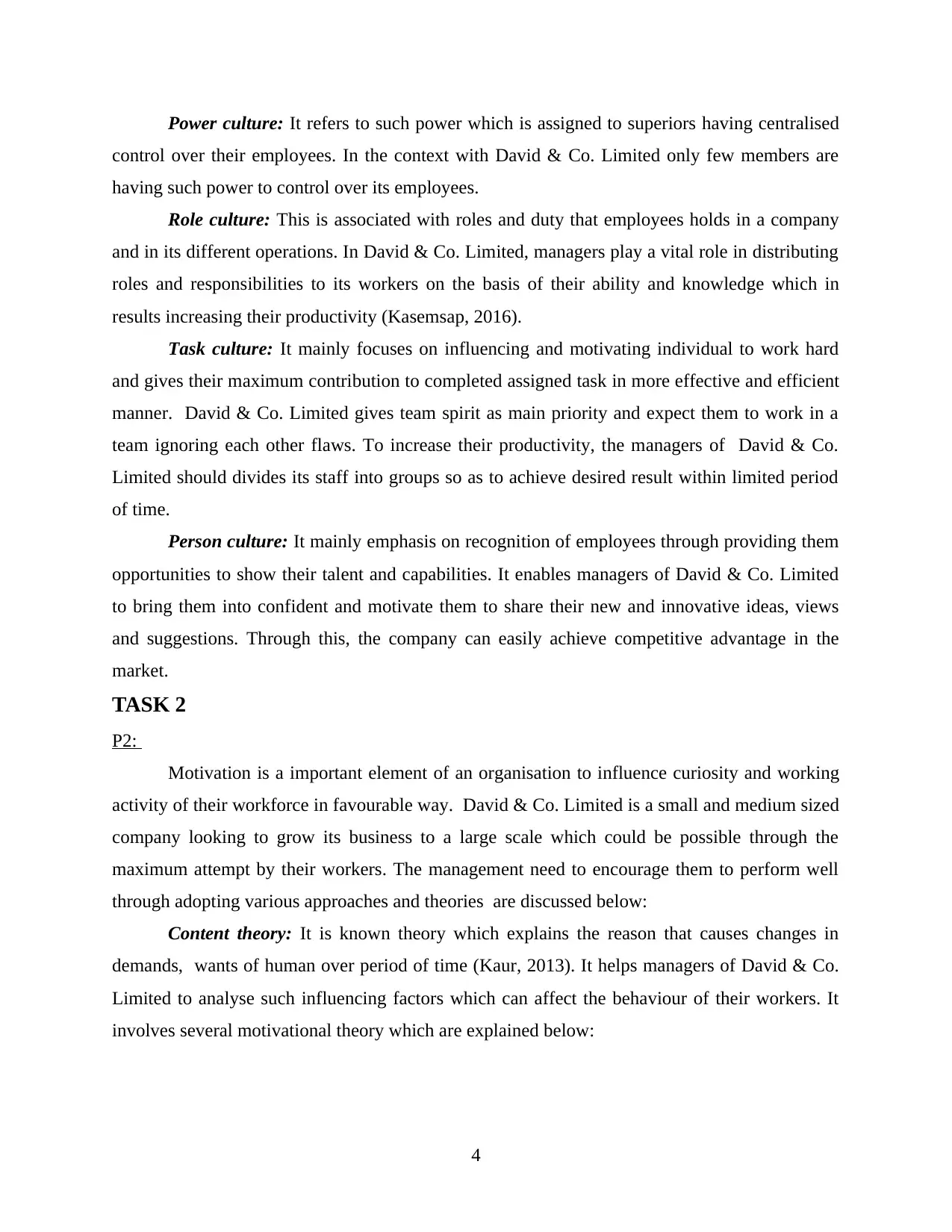
Power culture: It refers to such power which is assigned to superiors having centralised
control over their employees. In the context with David & Co. Limited only few members are
having such power to control over its employees.
Role culture: This is associated with roles and duty that employees holds in a company
and in its different operations. In David & Co. Limited, managers play a vital role in distributing
roles and responsibilities to its workers on the basis of their ability and knowledge which in
results increasing their productivity (Kasemsap, 2016).
Task culture: It mainly focuses on influencing and motivating individual to work hard
and gives their maximum contribution to completed assigned task in more effective and efficient
manner. David & Co. Limited gives team spirit as main priority and expect them to work in a
team ignoring each other flaws. To increase their productivity, the managers of David & Co.
Limited should divides its staff into groups so as to achieve desired result within limited period
of time.
Person culture: It mainly emphasis on recognition of employees through providing them
opportunities to show their talent and capabilities. It enables managers of David & Co. Limited
to bring them into confident and motivate them to share their new and innovative ideas, views
and suggestions. Through this, the company can easily achieve competitive advantage in the
market.
TASK 2
P2:
Motivation is a important element of an organisation to influence curiosity and working
activity of their workforce in favourable way. David & Co. Limited is a small and medium sized
company looking to grow its business to a large scale which could be possible through the
maximum attempt by their workers. The management need to encourage them to perform well
through adopting various approaches and theories are discussed below:
Content theory: It is known theory which explains the reason that causes changes in
demands, wants of human over period of time (Kaur, 2013). It helps managers of David & Co.
Limited to analyse such influencing factors which can affect the behaviour of their workers. It
involves several motivational theory which are explained below:
4
control over their employees. In the context with David & Co. Limited only few members are
having such power to control over its employees.
Role culture: This is associated with roles and duty that employees holds in a company
and in its different operations. In David & Co. Limited, managers play a vital role in distributing
roles and responsibilities to its workers on the basis of their ability and knowledge which in
results increasing their productivity (Kasemsap, 2016).
Task culture: It mainly focuses on influencing and motivating individual to work hard
and gives their maximum contribution to completed assigned task in more effective and efficient
manner. David & Co. Limited gives team spirit as main priority and expect them to work in a
team ignoring each other flaws. To increase their productivity, the managers of David & Co.
Limited should divides its staff into groups so as to achieve desired result within limited period
of time.
Person culture: It mainly emphasis on recognition of employees through providing them
opportunities to show their talent and capabilities. It enables managers of David & Co. Limited
to bring them into confident and motivate them to share their new and innovative ideas, views
and suggestions. Through this, the company can easily achieve competitive advantage in the
market.
TASK 2
P2:
Motivation is a important element of an organisation to influence curiosity and working
activity of their workforce in favourable way. David & Co. Limited is a small and medium sized
company looking to grow its business to a large scale which could be possible through the
maximum attempt by their workers. The management need to encourage them to perform well
through adopting various approaches and theories are discussed below:
Content theory: It is known theory which explains the reason that causes changes in
demands, wants of human over period of time (Kaur, 2013). It helps managers of David & Co.
Limited to analyse such influencing factors which can affect the behaviour of their workers. It
involves several motivational theory which are explained below:
4
⊘ This is a preview!⊘
Do you want full access?
Subscribe today to unlock all pages.

Trusted by 1+ million students worldwide
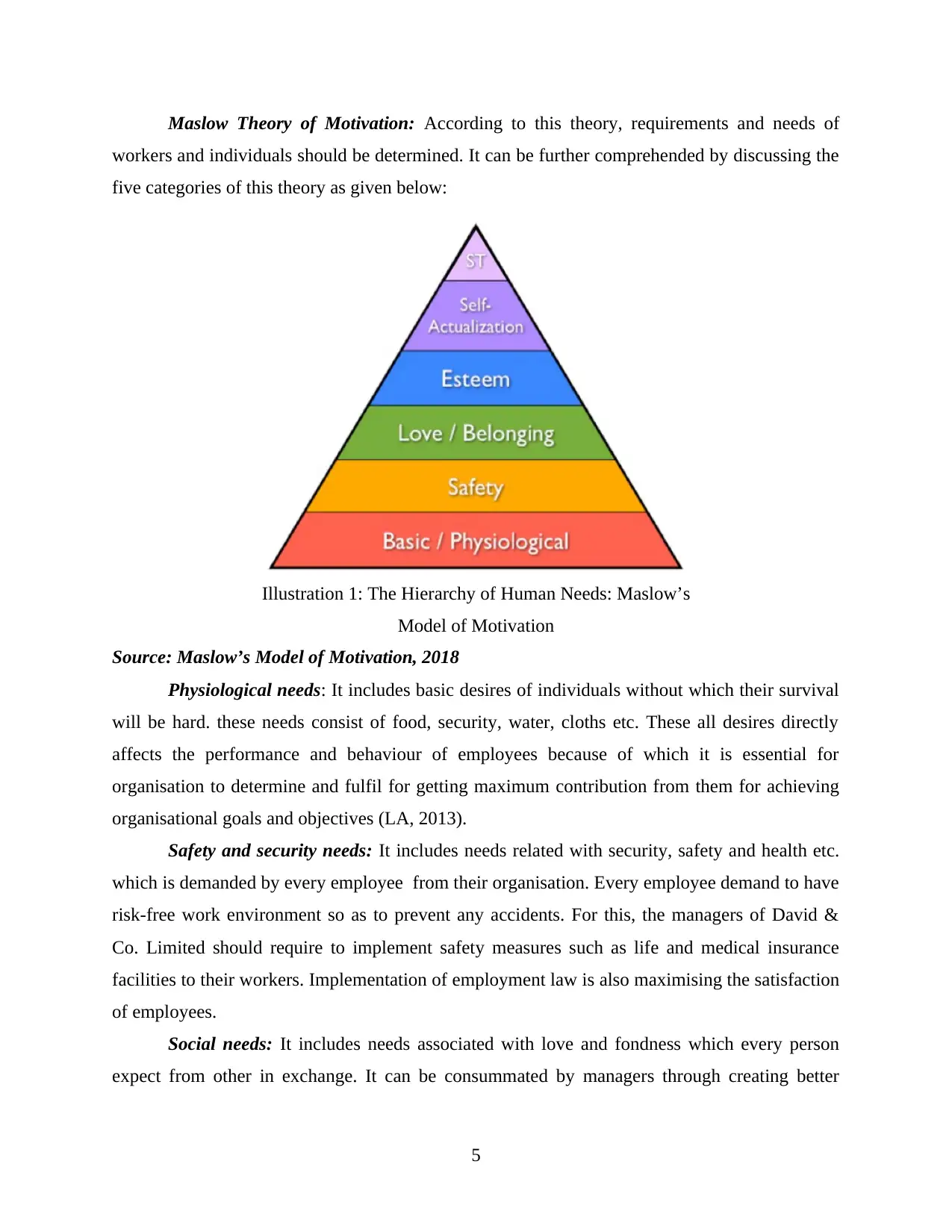
Maslow Theory of Motivation: According to this theory, requirements and needs of
workers and individuals should be determined. It can be further comprehended by discussing the
five categories of this theory as given below:
Source: Maslow’s Model of Motivation, 2018
Physiological needs: It includes basic desires of individuals without which their survival
will be hard. these needs consist of food, security, water, cloths etc. These all desires directly
affects the performance and behaviour of employees because of which it is essential for
organisation to determine and fulfil for getting maximum contribution from them for achieving
organisational goals and objectives (LA, 2013).
Safety and security needs: It includes needs related with security, safety and health etc.
which is demanded by every employee from their organisation. Every employee demand to have
risk-free work environment so as to prevent any accidents. For this, the managers of David &
Co. Limited should require to implement safety measures such as life and medical insurance
facilities to their workers. Implementation of employment law is also maximising the satisfaction
of employees.
Social needs: It includes needs associated with love and fondness which every person
expect from other in exchange. It can be consummated by managers through creating better
5
Illustration 1: The Hierarchy of Human Needs: Maslow’s
Model of Motivation
workers and individuals should be determined. It can be further comprehended by discussing the
five categories of this theory as given below:
Source: Maslow’s Model of Motivation, 2018
Physiological needs: It includes basic desires of individuals without which their survival
will be hard. these needs consist of food, security, water, cloths etc. These all desires directly
affects the performance and behaviour of employees because of which it is essential for
organisation to determine and fulfil for getting maximum contribution from them for achieving
organisational goals and objectives (LA, 2013).
Safety and security needs: It includes needs related with security, safety and health etc.
which is demanded by every employee from their organisation. Every employee demand to have
risk-free work environment so as to prevent any accidents. For this, the managers of David &
Co. Limited should require to implement safety measures such as life and medical insurance
facilities to their workers. Implementation of employment law is also maximising the satisfaction
of employees.
Social needs: It includes needs associated with love and fondness which every person
expect from other in exchange. It can be consummated by managers through creating better
5
Illustration 1: The Hierarchy of Human Needs: Maslow’s
Model of Motivation
Paraphrase This Document
Need a fresh take? Get an instant paraphrase of this document with our AI Paraphraser
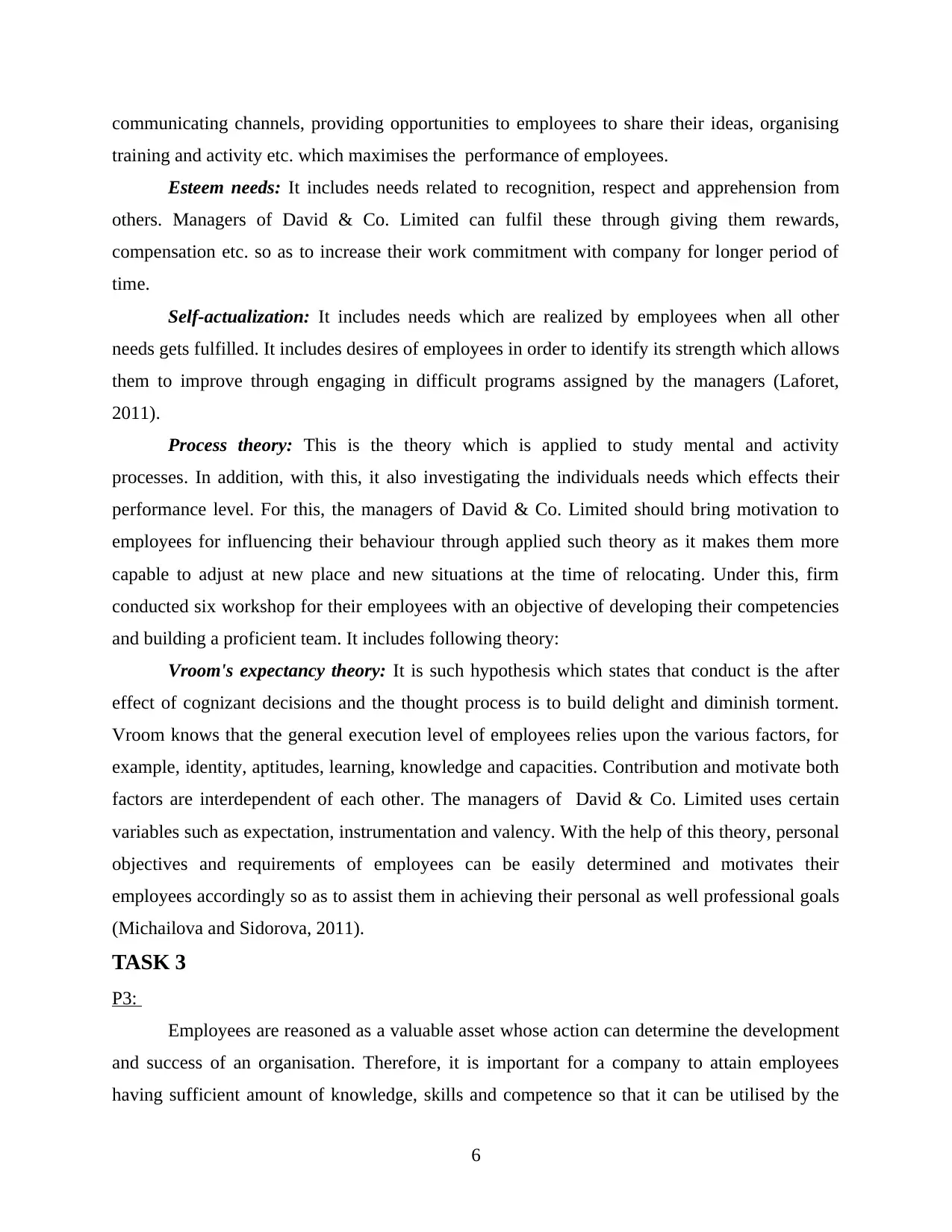
communicating channels, providing opportunities to employees to share their ideas, organising
training and activity etc. which maximises the performance of employees.
Esteem needs: It includes needs related to recognition, respect and apprehension from
others. Managers of David & Co. Limited can fulfil these through giving them rewards,
compensation etc. so as to increase their work commitment with company for longer period of
time.
Self-actualization: It includes needs which are realized by employees when all other
needs gets fulfilled. It includes desires of employees in order to identify its strength which allows
them to improve through engaging in difficult programs assigned by the managers (Laforet,
2011).
Process theory: This is the theory which is applied to study mental and activity
processes. In addition, with this, it also investigating the individuals needs which effects their
performance level. For this, the managers of David & Co. Limited should bring motivation to
employees for influencing their behaviour through applied such theory as it makes them more
capable to adjust at new place and new situations at the time of relocating. Under this, firm
conducted six workshop for their employees with an objective of developing their competencies
and building a proficient team. It includes following theory:
Vroom's expectancy theory: It is such hypothesis which states that conduct is the after
effect of cognizant decisions and the thought process is to build delight and diminish torment.
Vroom knows that the general execution level of employees relies upon the various factors, for
example, identity, aptitudes, learning, knowledge and capacities. Contribution and motivate both
factors are interdependent of each other. The managers of David & Co. Limited uses certain
variables such as expectation, instrumentation and valency. With the help of this theory, personal
objectives and requirements of employees can be easily determined and motivates their
employees accordingly so as to assist them in achieving their personal as well professional goals
(Michailova and Sidorova, 2011).
TASK 3
P3:
Employees are reasoned as a valuable asset whose action can determine the development
and success of an organisation. Therefore, it is important for a company to attain employees
having sufficient amount of knowledge, skills and competence so that it can be utilised by the
6
training and activity etc. which maximises the performance of employees.
Esteem needs: It includes needs related to recognition, respect and apprehension from
others. Managers of David & Co. Limited can fulfil these through giving them rewards,
compensation etc. so as to increase their work commitment with company for longer period of
time.
Self-actualization: It includes needs which are realized by employees when all other
needs gets fulfilled. It includes desires of employees in order to identify its strength which allows
them to improve through engaging in difficult programs assigned by the managers (Laforet,
2011).
Process theory: This is the theory which is applied to study mental and activity
processes. In addition, with this, it also investigating the individuals needs which effects their
performance level. For this, the managers of David & Co. Limited should bring motivation to
employees for influencing their behaviour through applied such theory as it makes them more
capable to adjust at new place and new situations at the time of relocating. Under this, firm
conducted six workshop for their employees with an objective of developing their competencies
and building a proficient team. It includes following theory:
Vroom's expectancy theory: It is such hypothesis which states that conduct is the after
effect of cognizant decisions and the thought process is to build delight and diminish torment.
Vroom knows that the general execution level of employees relies upon the various factors, for
example, identity, aptitudes, learning, knowledge and capacities. Contribution and motivate both
factors are interdependent of each other. The managers of David & Co. Limited uses certain
variables such as expectation, instrumentation and valency. With the help of this theory, personal
objectives and requirements of employees can be easily determined and motivates their
employees accordingly so as to assist them in achieving their personal as well professional goals
(Michailova and Sidorova, 2011).
TASK 3
P3:
Employees are reasoned as a valuable asset whose action can determine the development
and success of an organisation. Therefore, it is important for a company to attain employees
having sufficient amount of knowledge, skills and competence so that it can be utilised by the
6
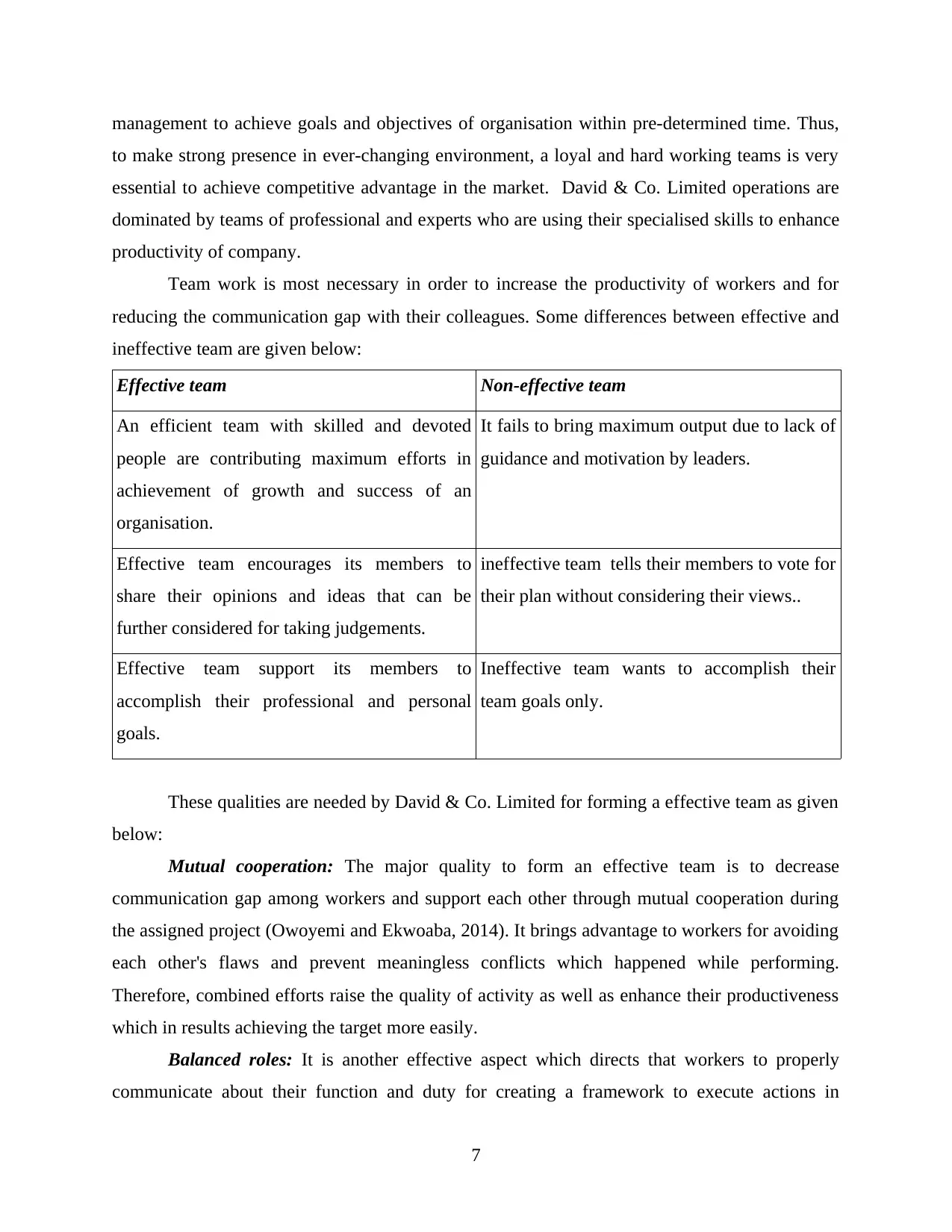
management to achieve goals and objectives of organisation within pre-determined time. Thus,
to make strong presence in ever-changing environment, a loyal and hard working teams is very
essential to achieve competitive advantage in the market. David & Co. Limited operations are
dominated by teams of professional and experts who are using their specialised skills to enhance
productivity of company.
Team work is most necessary in order to increase the productivity of workers and for
reducing the communication gap with their colleagues. Some differences between effective and
ineffective team are given below:
Effective team Non-effective team
An efficient team with skilled and devoted
people are contributing maximum efforts in
achievement of growth and success of an
organisation.
It fails to bring maximum output due to lack of
guidance and motivation by leaders.
Effective team encourages its members to
share their opinions and ideas that can be
further considered for taking judgements.
ineffective team tells their members to vote for
their plan without considering their views..
Effective team support its members to
accomplish their professional and personal
goals.
Ineffective team wants to accomplish their
team goals only.
These qualities are needed by David & Co. Limited for forming a effective team as given
below:
Mutual cooperation: The major quality to form an effective team is to decrease
communication gap among workers and support each other through mutual cooperation during
the assigned project (Owoyemi and Ekwoaba, 2014). It brings advantage to workers for avoiding
each other's flaws and prevent meaningless conflicts which happened while performing.
Therefore, combined efforts raise the quality of activity as well as enhance their productiveness
which in results achieving the target more easily.
Balanced roles: It is another effective aspect which directs that workers to properly
communicate about their function and duty for creating a framework to execute actions in
7
to make strong presence in ever-changing environment, a loyal and hard working teams is very
essential to achieve competitive advantage in the market. David & Co. Limited operations are
dominated by teams of professional and experts who are using their specialised skills to enhance
productivity of company.
Team work is most necessary in order to increase the productivity of workers and for
reducing the communication gap with their colleagues. Some differences between effective and
ineffective team are given below:
Effective team Non-effective team
An efficient team with skilled and devoted
people are contributing maximum efforts in
achievement of growth and success of an
organisation.
It fails to bring maximum output due to lack of
guidance and motivation by leaders.
Effective team encourages its members to
share their opinions and ideas that can be
further considered for taking judgements.
ineffective team tells their members to vote for
their plan without considering their views..
Effective team support its members to
accomplish their professional and personal
goals.
Ineffective team wants to accomplish their
team goals only.
These qualities are needed by David & Co. Limited for forming a effective team as given
below:
Mutual cooperation: The major quality to form an effective team is to decrease
communication gap among workers and support each other through mutual cooperation during
the assigned project (Owoyemi and Ekwoaba, 2014). It brings advantage to workers for avoiding
each other's flaws and prevent meaningless conflicts which happened while performing.
Therefore, combined efforts raise the quality of activity as well as enhance their productiveness
which in results achieving the target more easily.
Balanced roles: It is another effective aspect which directs that workers to properly
communicate about their function and duty for creating a framework to execute actions in
7
⊘ This is a preview!⊘
Do you want full access?
Subscribe today to unlock all pages.

Trusted by 1+ million students worldwide
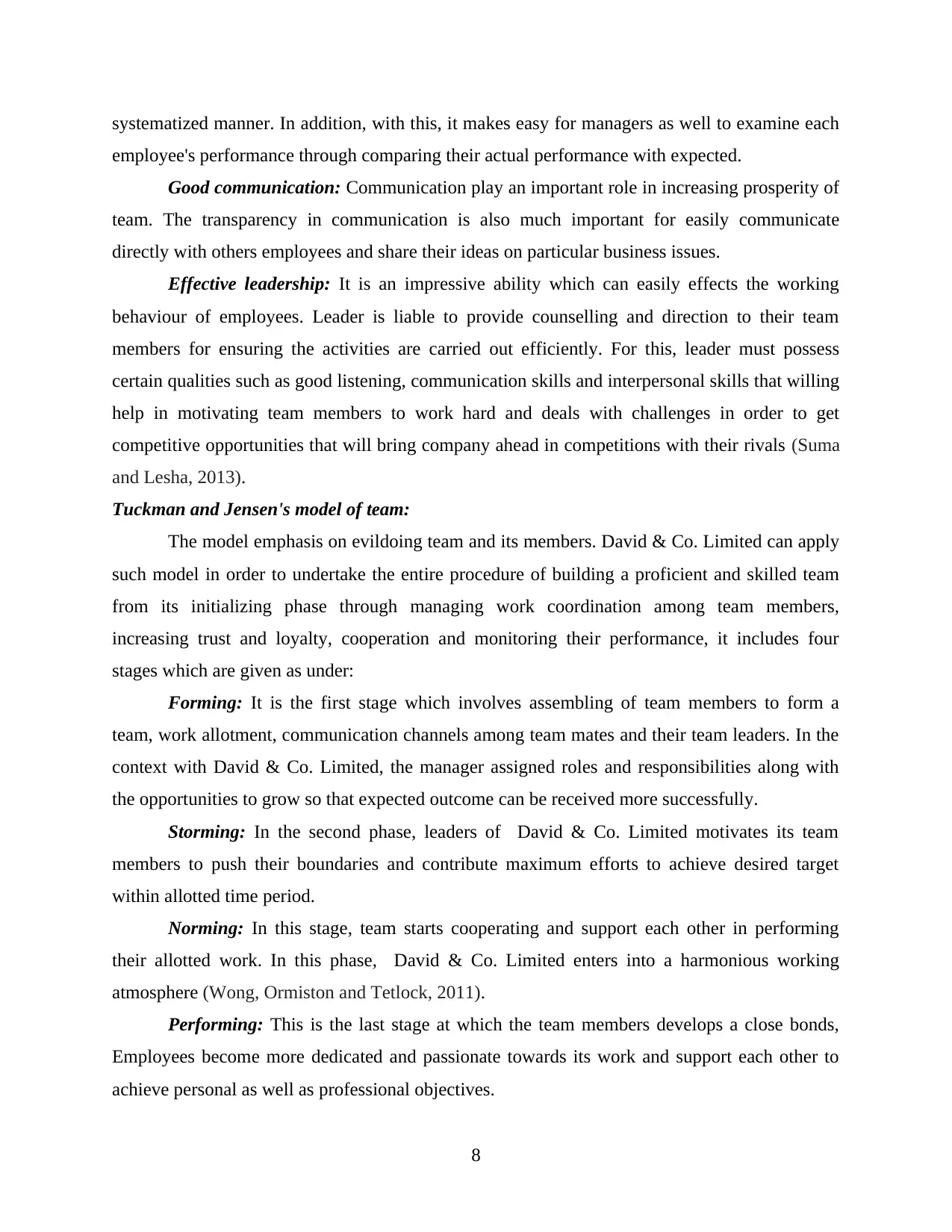
systematized manner. In addition, with this, it makes easy for managers as well to examine each
employee's performance through comparing their actual performance with expected.
Good communication: Communication play an important role in increasing prosperity of
team. The transparency in communication is also much important for easily communicate
directly with others employees and share their ideas on particular business issues.
Effective leadership: It is an impressive ability which can easily effects the working
behaviour of employees. Leader is liable to provide counselling and direction to their team
members for ensuring the activities are carried out efficiently. For this, leader must possess
certain qualities such as good listening, communication skills and interpersonal skills that willing
help in motivating team members to work hard and deals with challenges in order to get
competitive opportunities that will bring company ahead in competitions with their rivals (Suma
and Lesha, 2013).
Tuckman and Jensen's model of team:
The model emphasis on evildoing team and its members. David & Co. Limited can apply
such model in order to undertake the entire procedure of building a proficient and skilled team
from its initializing phase through managing work coordination among team members,
increasing trust and loyalty, cooperation and monitoring their performance, it includes four
stages which are given as under:
Forming: It is the first stage which involves assembling of team members to form a
team, work allotment, communication channels among team mates and their team leaders. In the
context with David & Co. Limited, the manager assigned roles and responsibilities along with
the opportunities to grow so that expected outcome can be received more successfully.
Storming: In the second phase, leaders of David & Co. Limited motivates its team
members to push their boundaries and contribute maximum efforts to achieve desired target
within allotted time period.
Norming: In this stage, team starts cooperating and support each other in performing
their allotted work. In this phase, David & Co. Limited enters into a harmonious working
atmosphere (Wong, Ormiston and Tetlock, 2011).
Performing: This is the last stage at which the team members develops a close bonds,
Employees become more dedicated and passionate towards its work and support each other to
achieve personal as well as professional objectives.
8
employee's performance through comparing their actual performance with expected.
Good communication: Communication play an important role in increasing prosperity of
team. The transparency in communication is also much important for easily communicate
directly with others employees and share their ideas on particular business issues.
Effective leadership: It is an impressive ability which can easily effects the working
behaviour of employees. Leader is liable to provide counselling and direction to their team
members for ensuring the activities are carried out efficiently. For this, leader must possess
certain qualities such as good listening, communication skills and interpersonal skills that willing
help in motivating team members to work hard and deals with challenges in order to get
competitive opportunities that will bring company ahead in competitions with their rivals (Suma
and Lesha, 2013).
Tuckman and Jensen's model of team:
The model emphasis on evildoing team and its members. David & Co. Limited can apply
such model in order to undertake the entire procedure of building a proficient and skilled team
from its initializing phase through managing work coordination among team members,
increasing trust and loyalty, cooperation and monitoring their performance, it includes four
stages which are given as under:
Forming: It is the first stage which involves assembling of team members to form a
team, work allotment, communication channels among team mates and their team leaders. In the
context with David & Co. Limited, the manager assigned roles and responsibilities along with
the opportunities to grow so that expected outcome can be received more successfully.
Storming: In the second phase, leaders of David & Co. Limited motivates its team
members to push their boundaries and contribute maximum efforts to achieve desired target
within allotted time period.
Norming: In this stage, team starts cooperating and support each other in performing
their allotted work. In this phase, David & Co. Limited enters into a harmonious working
atmosphere (Wong, Ormiston and Tetlock, 2011).
Performing: This is the last stage at which the team members develops a close bonds,
Employees become more dedicated and passionate towards its work and support each other to
achieve personal as well as professional objectives.
8
Paraphrase This Document
Need a fresh take? Get an instant paraphrase of this document with our AI Paraphraser
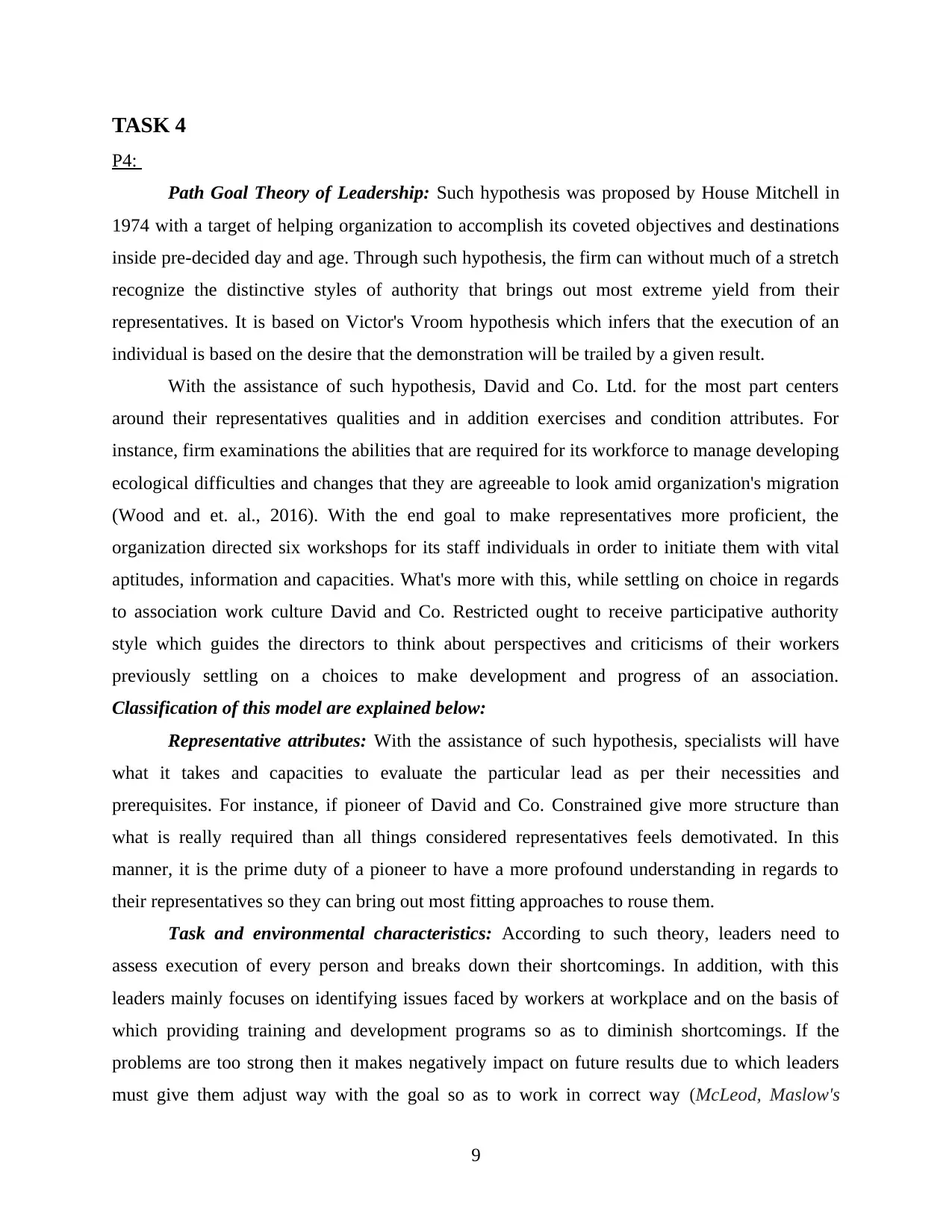
TASK 4
P4:
Path Goal Theory of Leadership: Such hypothesis was proposed by House Mitchell in
1974 with a target of helping organization to accomplish its coveted objectives and destinations
inside pre-decided day and age. Through such hypothesis, the firm can without much of a stretch
recognize the distinctive styles of authority that brings out most extreme yield from their
representatives. It is based on Victor's Vroom hypothesis which infers that the execution of an
individual is based on the desire that the demonstration will be trailed by a given result.
With the assistance of such hypothesis, David and Co. Ltd. for the most part centers
around their representatives qualities and in addition exercises and condition attributes. For
instance, firm examinations the abilities that are required for its workforce to manage developing
ecological difficulties and changes that they are agreeable to look amid organization's migration
(Wood and et. al., 2016). With the end goal to make representatives more proficient, the
organization directed six workshops for its staff individuals in order to initiate them with vital
aptitudes, information and capacities. What's more with this, while settling on choice in regards
to association work culture David and Co. Restricted ought to receive participative authority
style which guides the directors to think about perspectives and criticisms of their workers
previously settling on a choices to make development and progress of an association.
Classification of this model are explained below:
Representative attributes: With the assistance of such hypothesis, specialists will have
what it takes and capacities to evaluate the particular lead as per their necessities and
prerequisites. For instance, if pioneer of David and Co. Constrained give more structure than
what is really required than all things considered representatives feels demotivated. In this
manner, it is the prime duty of a pioneer to have a more profound understanding in regards to
their representatives so they can bring out most fitting approaches to rouse them.
Task and environmental characteristics: According to such theory, leaders need to
assess execution of every person and breaks down their shortcomings. In addition, with this
leaders mainly focuses on identifying issues faced by workers at workplace and on the basis of
which providing training and development programs so as to diminish shortcomings. If the
problems are too strong then it makes negatively impact on future results due to which leaders
must give them adjust way with the goal so as to work in correct way (McLeod, Maslow's
9
P4:
Path Goal Theory of Leadership: Such hypothesis was proposed by House Mitchell in
1974 with a target of helping organization to accomplish its coveted objectives and destinations
inside pre-decided day and age. Through such hypothesis, the firm can without much of a stretch
recognize the distinctive styles of authority that brings out most extreme yield from their
representatives. It is based on Victor's Vroom hypothesis which infers that the execution of an
individual is based on the desire that the demonstration will be trailed by a given result.
With the assistance of such hypothesis, David and Co. Ltd. for the most part centers
around their representatives qualities and in addition exercises and condition attributes. For
instance, firm examinations the abilities that are required for its workforce to manage developing
ecological difficulties and changes that they are agreeable to look amid organization's migration
(Wood and et. al., 2016). With the end goal to make representatives more proficient, the
organization directed six workshops for its staff individuals in order to initiate them with vital
aptitudes, information and capacities. What's more with this, while settling on choice in regards
to association work culture David and Co. Restricted ought to receive participative authority
style which guides the directors to think about perspectives and criticisms of their workers
previously settling on a choices to make development and progress of an association.
Classification of this model are explained below:
Representative attributes: With the assistance of such hypothesis, specialists will have
what it takes and capacities to evaluate the particular lead as per their necessities and
prerequisites. For instance, if pioneer of David and Co. Constrained give more structure than
what is really required than all things considered representatives feels demotivated. In this
manner, it is the prime duty of a pioneer to have a more profound understanding in regards to
their representatives so they can bring out most fitting approaches to rouse them.
Task and environmental characteristics: According to such theory, leaders need to
assess execution of every person and breaks down their shortcomings. In addition, with this
leaders mainly focuses on identifying issues faced by workers at workplace and on the basis of
which providing training and development programs so as to diminish shortcomings. If the
problems are too strong then it makes negatively impact on future results due to which leaders
must give them adjust way with the goal so as to work in correct way (McLeod, Maslow's
9
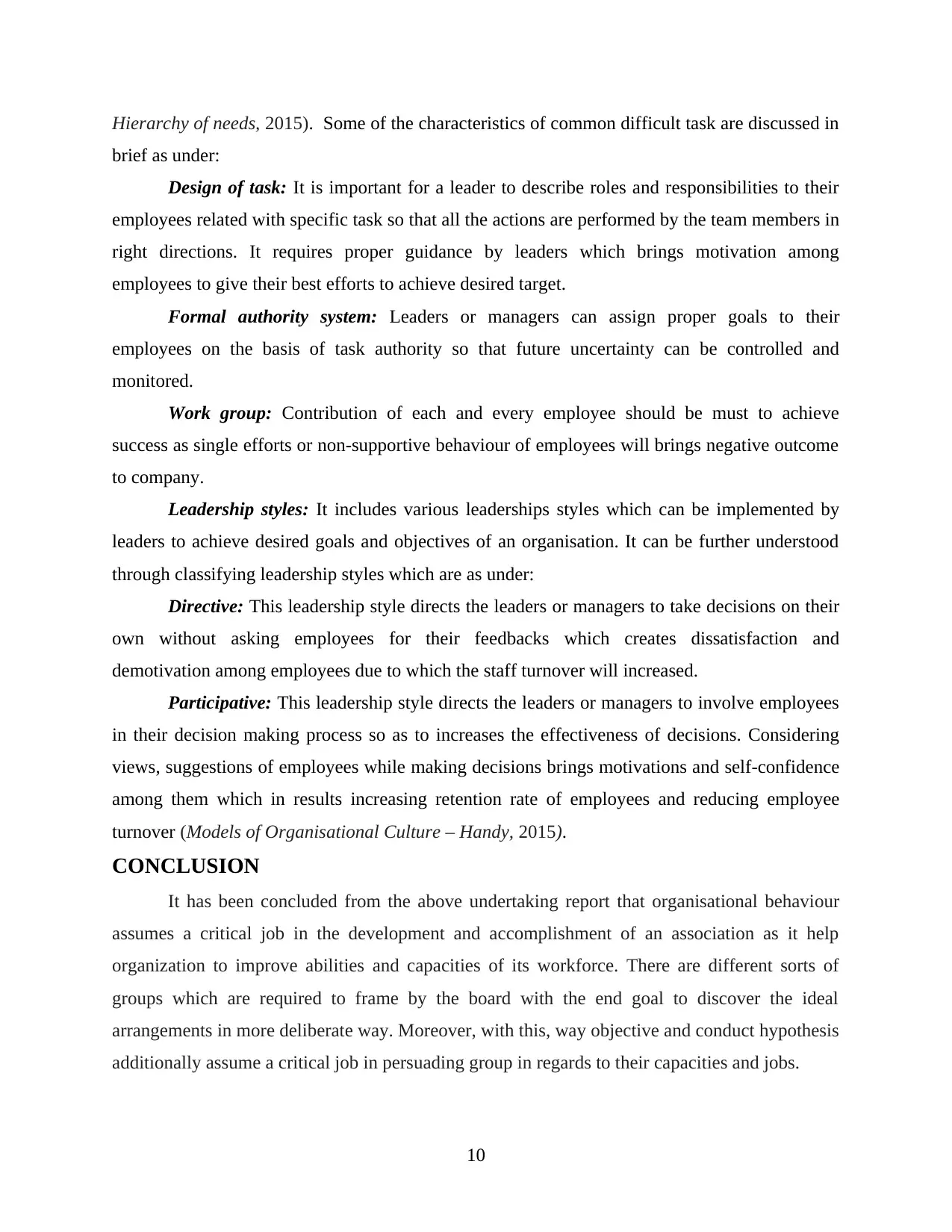
Hierarchy of needs, 2015). Some of the characteristics of common difficult task are discussed in
brief as under:
Design of task: It is important for a leader to describe roles and responsibilities to their
employees related with specific task so that all the actions are performed by the team members in
right directions. It requires proper guidance by leaders which brings motivation among
employees to give their best efforts to achieve desired target.
Formal authority system: Leaders or managers can assign proper goals to their
employees on the basis of task authority so that future uncertainty can be controlled and
monitored.
Work group: Contribution of each and every employee should be must to achieve
success as single efforts or non-supportive behaviour of employees will brings negative outcome
to company.
Leadership styles: It includes various leaderships styles which can be implemented by
leaders to achieve desired goals and objectives of an organisation. It can be further understood
through classifying leadership styles which are as under:
Directive: This leadership style directs the leaders or managers to take decisions on their
own without asking employees for their feedbacks which creates dissatisfaction and
demotivation among employees due to which the staff turnover will increased.
Participative: This leadership style directs the leaders or managers to involve employees
in their decision making process so as to increases the effectiveness of decisions. Considering
views, suggestions of employees while making decisions brings motivations and self-confidence
among them which in results increasing retention rate of employees and reducing employee
turnover (Models of Organisational Culture – Handy, 2015).
CONCLUSION
It has been concluded from the above undertaking report that organisational behaviour
assumes a critical job in the development and accomplishment of an association as it help
organization to improve abilities and capacities of its workforce. There are different sorts of
groups which are required to frame by the board with the end goal to discover the ideal
arrangements in more deliberate way. Moreover, with this, way objective and conduct hypothesis
additionally assume a critical job in persuading group in regards to their capacities and jobs.
10
brief as under:
Design of task: It is important for a leader to describe roles and responsibilities to their
employees related with specific task so that all the actions are performed by the team members in
right directions. It requires proper guidance by leaders which brings motivation among
employees to give their best efforts to achieve desired target.
Formal authority system: Leaders or managers can assign proper goals to their
employees on the basis of task authority so that future uncertainty can be controlled and
monitored.
Work group: Contribution of each and every employee should be must to achieve
success as single efforts or non-supportive behaviour of employees will brings negative outcome
to company.
Leadership styles: It includes various leaderships styles which can be implemented by
leaders to achieve desired goals and objectives of an organisation. It can be further understood
through classifying leadership styles which are as under:
Directive: This leadership style directs the leaders or managers to take decisions on their
own without asking employees for their feedbacks which creates dissatisfaction and
demotivation among employees due to which the staff turnover will increased.
Participative: This leadership style directs the leaders or managers to involve employees
in their decision making process so as to increases the effectiveness of decisions. Considering
views, suggestions of employees while making decisions brings motivations and self-confidence
among them which in results increasing retention rate of employees and reducing employee
turnover (Models of Organisational Culture – Handy, 2015).
CONCLUSION
It has been concluded from the above undertaking report that organisational behaviour
assumes a critical job in the development and accomplishment of an association as it help
organization to improve abilities and capacities of its workforce. There are different sorts of
groups which are required to frame by the board with the end goal to discover the ideal
arrangements in more deliberate way. Moreover, with this, way objective and conduct hypothesis
additionally assume a critical job in persuading group in regards to their capacities and jobs.
10
⊘ This is a preview!⊘
Do you want full access?
Subscribe today to unlock all pages.

Trusted by 1+ million students worldwide
1 out of 14
Related Documents
Your All-in-One AI-Powered Toolkit for Academic Success.
+13062052269
info@desklib.com
Available 24*7 on WhatsApp / Email
![[object Object]](/_next/static/media/star-bottom.7253800d.svg)
Unlock your academic potential
Copyright © 2020–2025 A2Z Services. All Rights Reserved. Developed and managed by ZUCOL.





